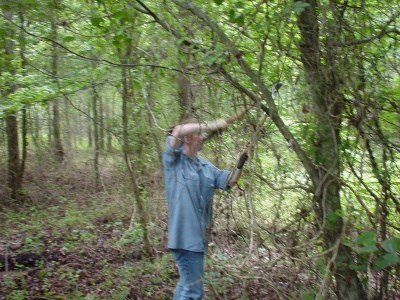
On January 17, 1781 at the Cow Pens, a well-known pasturing area in the upcountry of South Carolina, Brigadier General Daniel Morgan with his untrained, but experienced militia and 600 Continentals, used the setting to rout the British army under Lieutenant Colonel Banastre Tarleton in the only double envelopment to occur in the American Revolution. This decisive battle led to the British defeat at Yorktown nine months later.
On March 4, 1929, the United States Congress recognized the importance of the battle by creating Cowpens National Battlefield Site on one acre of donated land. In 1972 Congress authorized the purchase of about 845 acres of land and changed the name to Cowpens National Battlefield. The purchase included the entire battlefield and a buffer zone around it so that visitors would be able to explore the battlefield without modern-day intrusions. The Master Plan for the development of Cowpens National Battlefield stated:
"By careful handling of the natural vegetation, the area within the park boundary will eventually come to resemble its appearance in Colonial [sic] times. The pasturelands and woodlands will again be in their historic relationship… The Cowpens National Battlefield of the future, as thus envisioned, will offer a meaningful experience for the visitor, who has come to learn more about the great heritage upon which this Nation [sic] was built."
As a unit of the National Park System, Cowpens National Battlefield protects and preserves the historic scene. Protection means taking care of the battlefield for this and future generations. Preservation means restoring the battlefield to its appearance in 1781. 
How did the battlefield look on January 17, 1781?To determine how it looked at the time of the battle, the National Park Service used first hand accounts from the soldiers who fought here that morning. "…[T]he woods were open and free from swamps…" -- Banastre Tarleton
"The battle was fought early in the morning in the open woods." -- Josiah Martin
"…The battle ground [sic] was part in the woods & part an old field…" -- James Kelly
"…[T]he land was thickly covered with red oak and hickory, with little if any underbrush." -- Samuel Hammond
“The battle field [sic] was almost a plain with a ravine on both hands, and very little under growth [sic] in front or near us.” -- Thomas Young Restoration Efforts
After the expanded park and Visitor Center opened in 1980, park managers concentrated on keeping the core battlefield open as it was in 1781, while letting much of the land revert to forest. However in2000, Cowpens National Battlefield began major restoration. The Palmetto Conservation Foundation partnered with the park to provide research, manpower, and consultation about best restoration practices. To return the park to the forage and trees native at the time of the battle, the National Park Service removed early succession trees such as sweetgum and wild cherry and replaced them with oaks, yellow poplars, and maples. Based on current research, the battlefield core encompasses a larger area than originally thought. To restore these areas, the park is clears underbrush between large trees and reintroduces native grasses using various methods of restoration. 
Restoration Methods Mechanical restoration is the use of machinery to perform selective thinning of small trees and underbrush. Cowpens National Battlefield has used traditional mowers, industrial rotary mowers, and contracted for large equipment to remove the underbrush and open up the woods. Mechanical reduction has the advantage of showing immediate results, but hidden obstructions are hard on the equipment. 
Manual labor includes periodic employment of crews to remove invasive exotic plant species which were not native to the area in 1781 and which are now prevalent in the park. Hand crews have trimmed trees and undergrowth, and replanted native hardwood species. The main benefit of using manual labor for the trimming and planting is that volunteers, youth, and less-skilled employees can do it. Unfortunately, it is labor intensive and hard to maintain. 
Periodic burning clears the forest floor and opens up the woodland. Native Americans and settlers used fire to clear underbrush in heavily wooded areas. Because fire is a natural occurrence, many native plants and animals flourish after a fire. The disadvantages of burning are that it requires a specialized team and ideal weather conditions, and can burn too hot and kill desired species, or not hot enough to do the required reduction. Your Tax Dollars at Work Each restoration method that the National Park Service employs helps restore certain aspects of the battlefield. Battlefield restoration is a long-term, ongoing project, and repetition is the only way to keep the battlefield open as it would have appeared in 1781. |
Last updated: April 14, 2015
